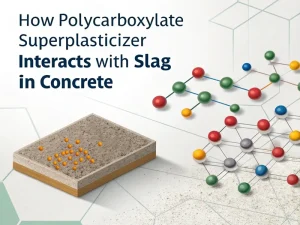Blog
Polycarboxylate is widely used in various industries, and its unique properties make it an important component in many applications. But what exactly is polycarboxylate? This article aims to provide a comprehensive overview of this versatile compound, including its definition, chemical structure, properties, applications, and more.
Polycarboxylate refers to a type of polymer with multiple carboxyl functional groups (- COOH) in its molecular structure, which is polymerized from monomers such as acrylic acid and maleic acid. Its side chains can be grafted with functional groups such as polyether and sulfonic acid. These carboxyl groups are the reason for many unique chemical and physical properties of the compound. Structurally speaking, polycarboxylates can have various structures, but one of the most well-known and widely used forms is polycarboxylate ether.
Polycarboxylate ether polymers typically have a comb-like structure. They are composed of a main chain, usually composed of carbon atoms, and have many side chains attached. Side chains are usually long polyethylene oxide (PEO) chains extending outward from the main chain. Carboxyl groups are either directly attached to the skeleton or part of the functional groups on the side chains. This unique comb-like structure endows polycarboxylates with outstanding performance in various applications, particularly in the field of concrete admixtures.
One of the most significant characteristics of polycarboxylates is their high water reduction efficiency. When used as a superplasticizer in concrete, polycarboxylates can significantly reduce the amount of water required to achieve the workability of concrete mixtures. It can effectively disperse cement particles and prevent them from clumping.
By reducing the moisture content while maintaining or even enhancing the fluidity of concrete, polycarboxylates help improve the overall quality of concrete. Polycarboxylate reduces the water-cement ratio, resulting in higher strength, better durability, and lower permeability of concrete.
Polycarboxylate salts also exhibit excellent dispersion stability. Once added to a system, such as a concrete mixture or pigment dispersion, it can maintain the dispersed state of particles for a long period. In concrete, this means that the workability of the concrete can be maintained for a longer period during transportation and pouring.
This characteristic is particularly beneficial in the application of ready-mixed concrete, as the concrete may need to be transported long distances from the batching plant to the construction site.
Another advantage of polycarboxylates is their good compatibility with various materials. In the construction industry, it can be well combined with different types of cement, including ordinary Portland cement, Portland blast furnace slag cement, and Portland fly ash cement.
This compatibility ensures that polycarboxylates can be used in various concrete formulations without causing adverse reactions or performance issues. In addition, polycarboxylates can also be combined with other additives, such as air-entraining agents and accelerators, to further customize the performance of concrete.
As a third-generation high-performance water reducer, polycarboxylate superplasticizer (PCE) surpasses traditional lignin or naphthalene-based products comprehensively
The water reduction rate is as high as 45%, reducing the water-cement ratio to 0.25-0.35 and increasing the concrete strength by more than 40%;
Slump retention: 2-hour loss rate<15%, ensuring the feasibility of long-distance transportation of commercial concrete;
Environmental advantages: free of formaldehyde and chloride ions, alkali content ≤ 0.2%, in line with LEED green building certification requirements.
Washing aids: Chelate calcium and magnesium ions to prevent soap scale deposition;
Pigment dispersant: stabilizes titanium dioxide and calcium carbonate suspensions through electrostatic repulsion to prevent sedimentation and agglomeration;
Food Thickener: Complies with food additive standards and is used to thicken jams and seasonings;
Water treatment agent: inhibits calcium carbonate scaling in cooling towers and improves industrial heat transfer efficiency.
With the continuous advancement of technology, the development of polycarboxylates is also constantly evolving. Researchers are working to further improve the performance of polycarboxylate-based products. For example, efforts are being made to develop polycarboxylate superplasticizers with higher water reduction efficiency and better adaptability to different types of cement and environmental conditions.
People are increasingly valuing the environmental friendliness of polycarboxylates. Developing more sustainable synthesis methods to reduce the environmental impact of polycarboxylate production and use is becoming an important research direction. In the future, due to the demand for high-performance and sustainable materials, polycarboxylates may play a more important role in various industries.
In summary, polycarboxylates are widely used and important compounds. Its unique chemical structure endows it with excellent performance, making it indispensable in many industries, especially in the construction industry.

How Polycarboxylate Polyether Monomer Affect Concrete Performance
Blog How Polycarboxylate

How Polycarboxylate Superplasticizer Interacts With Slag In Concrete
Blog How Polycarboxylate